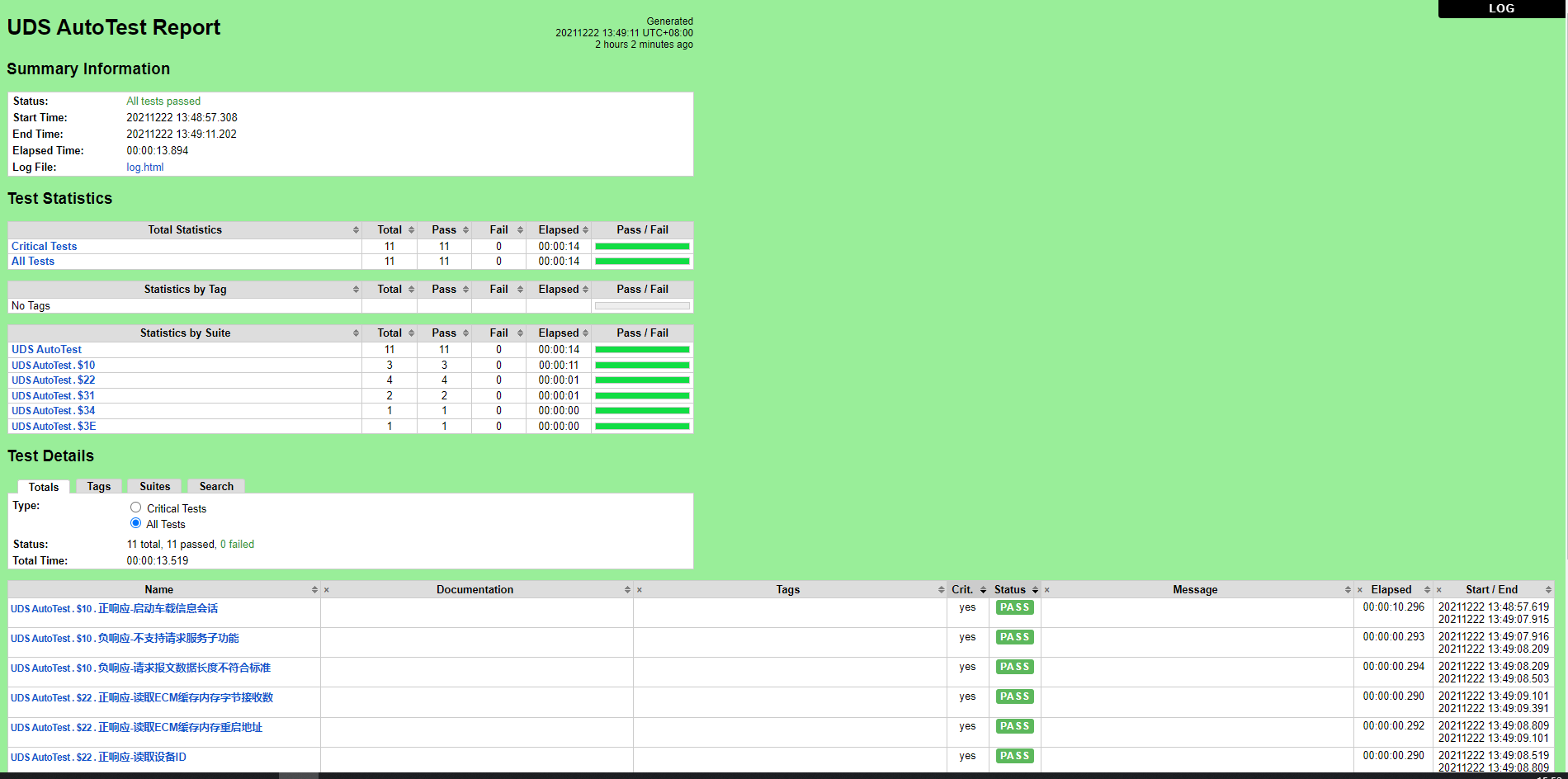一、环境搭建
1.概述
由于项目需要进行UDS诊断测试,所以对这方面进行了研究学习,网上很少能查询到相关资料,故记录一下UDS自动化测试开发过程,由于保密原则,案例都是Demo,希望能帮到感兴趣的朋友。
2.硬件环境

上位机:PCAN
PCAN-USB驱动:https://www.peak-system.com/fileadmin/media/files/pcan-basic.zip
下位机:ECM(发动机控制模块)
3.Python环境
下载地址:https://www.python.org/ftp/python/3.7.9/python-3.7.9-amd64.exe
pip3 install robotframework==3.2.2
pip3 install robotframework-ride==1.7.4.2
pip3 install xlrd==1.2.0
pip3 install udsoncan==1.14
pip3 install python-can==3.3.4
pip3 install can-isotp==1.7
二、项目介绍
1.文件目录

$10--$3E:L2层robot测试用例
Public.robot:L1层关键字方法
UDS_TestReport.zip:自动化测试报告
udstest.py:python封装自定义uds测试方法
UDSTestcase.xlsx:UDS诊断测试用例
2.udstest.py
# _*_ coding:utf-8 _*_ from can.interfaces.pcan.pcan import PcanBus from udsoncan.connections import PythonIsoTpConnection import xlrd, os, udsoncan, isotp, sys, binascii class udstest(object): def __init__(self): udsoncan.setup_logging() # udslog def get_xlsx(self, sheet): "获取指定Excel数据" excel = os.path.join(os.path.dirname(os.path.abspath(__file__)), 'UDSTestcase.xlsx') # 获取用例文件路径 file = xlrd.open_workbook(excel) list = [] sheet = file.sheet_by_name(sheet) # 获得指定sheet数据 row_value1 = sheet.row_values(0) # 获取第1行的标题 nrows = sheet.nrows # 获取当前sheet行数 ncols = sheet.ncols # 获取当前sheet列数 for i in range(1, nrows): # 从第2行遍历当前sheet row = sheet.row_values(i) # 获取行数据 dict = {} # 创建空字典 for j in range(0, ncols): # 遍历sheet列,组成字典 if row_value1[j] == 'NO.': dict[row_value1[j]] = int(row[j]) else: dict[row_value1[j]] = row[j] # 从第一列开始,将每一列的数据与第1行的数据组成一个键值对,形成字典 list.append(dict) # 将字典添加list中 return list def set_can(self, txid, rxid): """can总线相关配置""" if isinstance(txid, str) or isinstance(rxid, str): txid = eval(txid) rxid = eval(rxid) isotp_params = { 'stmin': 5, # 流控帧间隔时间,0-127ms 或 100-900ns 值从 0xF1-0xF9 'blocksize': 0, # 流控帧单包大小,0表示不限制 'tx_padding': 0, # 当 notNone表示用于填充发送的消息的字节。 'rx_flowcontrol_timeout': 1000, # 在停止接收和触发之前等待流控制帧的毫秒数 'rx_consecutive_frame_timeout': 1000, # 在停止接收和触发 a 之前等待连续帧的毫秒数 } try: self.canbus = PcanBus(channel='PCAN_USBBUS1', bitrate=500000) # CAN总线初始化 self.tp_addr = isotp.Address(isotp.AddressingMode.Normal_29bits, txid=txid, rxid=rxid) # 网络层寻址方法 tp_stack = isotp.CanStack(bus=self.canbus, address=self.tp_addr, params=isotp_params) # 网络/传输层(IsoTP 协议) self.conn = PythonIsoTpConnection(tp_stack) # 应用层和传输层之间建立连接 except: print(sys.exc_info()[1]) else: print('CAN配置成功') def uds_request_respond(self, request_command): """发送uds请求和接收uds响应""" if not isinstance(request_command, str): # 判断request_command数据类型 request_command = str(int(request_command)) requestPdu = binascii.a2b_hex(request_command.replace(' ', '')) # 处理request_command if not self.conn.is_open(): self.conn.open() # 打开连接 try: self.conn.specific_send(requestPdu) # 发送uds请求 except: print("发送请求失败") else: print('UDS发送请求:%s' % request_command) try: respPdu = self.conn.specific_wait_frame(timeout=3) # 接收uds响应 except: print('响应数据失败') else: res = respPdu.hex().upper() respond = '' for i in range(len(res)): if i % 2 == 0: respond += res[i] else: respond += res[i] + ' ' print('UDS响应结果:%s' % respond) self.conn.close() # 关闭连接 self.canbus.shutdown() # 关闭总线 return respond.strip()
3.UDSTestcase.xlsx

3.UDS_TestReport
